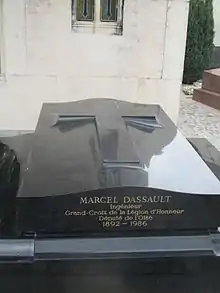Marcel Dassault
Marcel Dassault (born Marcel Bloch; 22 January 1892 – 17 April 1986) was a French industrialist who spent his career in aircraft manufacturing.
Marcel Dassault | |
|---|---|
 Marcel Bloch in 1914 | |
| Born | Marcel Bloch 22 January 1892 Paris, France |
| Died | 17 April 1986 (aged 94) Neuilly-sur-Seine, France |
| Resting place | Passy Cemetery |
| Nationality | French |
| Education | Lycée Condorcet |
| Alma mater | Breguet School[1] Supaéro |
| Occupation | aircraft designer and industrialist |
| Known for | founding Dassault Aviation |
| Spouse(s) | Madeleine Minckes |
| Children | Serge Dassault Claude Dassault |
| Awards | Daniel Guggenheim Medal (1976) |
Early life
Bloch was born on 22 January 1892 in Paris.[1] His parents were Jewish.
He was educated at Lycée Condorcet in Paris. After studies in Electrical Engineering[1] he graduated from the Breguet School and Supaéro. At the latter school Bloch was classmates with a Russian student named Mikhail Gurevich who would later be instrumental in the creation of the MiG aircraft series.[1]
Career
Bloch worked at the French Aeronautics Research Laboratory at Chalais-Meudon[1] during World War I and invented a type of aircraft propeller subsequently used by the French army during the conflict. In 1916, with Henry Potez and Louis Coroller, he formed a company, the Société d'Études Aéronautiques to produce the SEA series of fighters.[2]
In 1928 Bloch founded the aircraft company Société des Avions Marcel Bloch, which produced its first aircraft in 1930.[1]
In 1935 Bloch and Henry Potez entered into an agreement to buy Société Aérienne Bordelaise (SAB). In 1936 the company was nationalized as the Société Nationale de Constructions Aéronautiques du Sud Ouest (SNCASO). Bloch agreed to become the delegated administrator of the Minister for Air.[3]
During the occupation of France by Nazi Germany during World War II, France’s aviation industry was virtually disbanded,[4] other than the compulsory manufacturing, assembly and servicing of German designs. In October 1940, Bloch refused to collaborate with the Germans occupiers at Bordeaux-Aéronautique and was imprisoned by the Vichy government. In 1944 the Nazis deported Bloch to the Buchenwald concentration camp,[1] as punishment for refusing to co-operate with their regime. He was tortured and beaten and held in solitary confinement. In the meantime his wife was interned near Paris. Bloch was detained at Buchenwald until it was liberated on 11 April 1945. By the time of his return to Paris he was crippled to such an extent that he could barely walk. He was advised by his doctors to settle his affairs, as they did not expect him to recover his health. [1]
After the war he changed his name from Bloch to Bloch-Dassault and in 1949 to Dassault. Dassault was the nom de guerre used by his brother, General Darius Paul Bloch, when he served in the French resistance,[1] and is derived from char d'assaut, French for "battle tank".[note 1] In 1971 Dassault acquired Breguet, forming Avions Marcel Dassault-Breguet Aviation (AMD-BA).
Personal life
In 1919, Bloch married Madeleine Minckes, the daughter of a wealthy Jewish family of furniture dealers.[5] They had two sons, Claude and Serge.

After changing his name to Dassault, he converted to Roman Catholicism in 1950.[3][6][1]
In July 1952, Dassault acquired the Paris landmark buildings now known as Hôtel Marcel Dassault, dating from 1844,[7] at nos. 7 and 9 rond-point des Champs-Elysées (at the corner of the avenue des Champs-Élysées and avenue Montaigne), from the Sabatier d'Espeyran family.[8] The building at no. 7 has been used since 2002 by the auction house Artcurial, which had further alterations made under the direction of architect Jean-Michel Wilmotte.[7] While no. 7 has been sold, no. 9 is still used by the Groupe Industriel Marcel Dassault.
Death and memorials
Marcel Dassault died in Neuilly-sur-Seine in 1986 and was buried in the Passy Cemetery in the 16th arrondissement of Paris.
In 1973, Dassault was inducted into the International Air & Space Hall of Fame.[9]
Serge Dassault, Marcel's son, became CEO of Avions Marcel Dassault, which was restructured as Groupe Industriel Marcel Dassault, reflecting its broader interests. In 1990, the aviation division was renamed Dassault Aviation.
In 1991, the rond-point des Champs-Elysées was renamed the “rond-point des Champs-Elysées-Marcel Dassault” in his honor.
In popular culture
In The Adventures of Tintin book Flight 714 to Sydney, Dassault is parodied as the aircraft construction tycoon Laszlo Carreidas - "the millionaire who never laughs", who offers Tintin, Captain Haddock and Professor Calculus his personal jet, the Carreidas 160, to travel to Sydney.[10]
Notes
- char d'assaut means "battle tank" in French, but a word-for-word translation would be "assault wagon". D'assaut simply means "for assault".
References
- Aloni, Shlomo (2010). Mirage III vs MiG-21: Six Day War 1967 (Duel). ISBN 9781846039478.

- Aloni 2010, p. 8.
- Gunston, Bill (2005). World Encyclopedia ofAircraft Manufactureers (2nd ed.). Stroud, UK: Sutton Publishing. p. 371. ISBN 0-7509-3981-8.
- "History of Groupe Dassault Aviation". Retrieved 1 October 2012.
- Dassault Aviation History, 1916 to this day: During the War. Accessed 5 January 2006.
- Ottawa Citizen, "Madame a Prisoner Before" May 25, 1964
- Britannica Online: Marcel Dassault retrieved February 23, 2012
- "Hôtel Dassault-Artcurial". Evene.fr.
- The structure at no. 7, built in 1844, was altered over the years including work by Dassault's friend, architect Georges Hennequin (1893—1969). The neo-Louis XV-style domicile at no. 7, known previously as the Hôtel d'Espeyran, was built by architect Henri Parent for Félicie Durand 1819-1899, the widow of Frédéric Sabatier d'Espeyran 1813-1864.
- Sprekelmeyer, Linda, editor. These We Honor: The International Aerospace Hall of Fame. Donning Co. Publishers, 2006. ISBN 978-1-57864-397-4.
- Tintin: Hergé and His Creation. John Murray (Publishers) An Hachette UK Company. 2011. ISBN 978-1-84854-673-8.